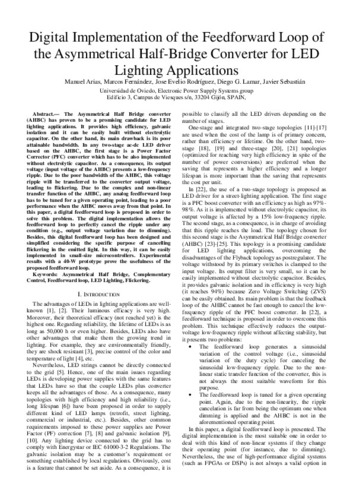Digital Implementation of the Feedforward Loop of the Asymmetrical Half-Bridge Converter for LED Lighting Applications
Palabra(s) clave:
Asymmetrical half bridge
Complementary control
Feedforward loop
LED lighting
Fecha de publicación:
Editorial:
IEEE
Versión del editor:
Citación:
Descripción física:
Resumen:
The Asymmetrical Half Bridge converter (AHBC) has proven to be a promising candidate for LED lighting applications. It provides high efficiency, galvanic isolation and it can be easily built without electrolytic capacitor. On the other hand, its main drawback is its poor attainable bandwidth. In any two-stage ac-dc LED driver based on the AHBC, the first stage is a Power Factor Corrector (PFC) converter which has to be also implemented without electrolytic capacitor. As a consequence, its output voltage (input voltage of the AHBC) presents a low-frequency ripple. Due to the poor bandwidth of the AHBC, this voltage ripple will be transferred to the converter output voltage, leading to flickering. Due to the complex and non-linear transfer function of the AHBC, any analog feedforward loop has to be tuned for a given operating point, leading to a poor performance when the AHBC moves away from that point. In this paper, a digital feedforward loop is proposed in order to solve this problem. The digital implementation allows the feedforward loop to perfectly cancel the ripple under any condition (e.g., output voltage variation due to dimming). Besides, this digital feedforward loop has been designed and simplified considering the specific purpose of cancelling flickering in the emitted light. In this way, it can be easily implemented in small-size microcontrollers. Experimental results with a 40-W prototype prove the usefulness of the proposed feedforward loop
The Asymmetrical Half Bridge converter (AHBC) has proven to be a promising candidate for LED lighting applications. It provides high efficiency, galvanic isolation and it can be easily built without electrolytic capacitor. On the other hand, its main drawback is its poor attainable bandwidth. In any two-stage ac-dc LED driver based on the AHBC, the first stage is a Power Factor Corrector (PFC) converter which has to be also implemented without electrolytic capacitor. As a consequence, its output voltage (input voltage of the AHBC) presents a low-frequency ripple. Due to the poor bandwidth of the AHBC, this voltage ripple will be transferred to the converter output voltage, leading to flickering. Due to the complex and non-linear transfer function of the AHBC, any analog feedforward loop has to be tuned for a given operating point, leading to a poor performance when the AHBC moves away from that point. In this paper, a digital feedforward loop is proposed in order to solve this problem. The digital implementation allows the feedforward loop to perfectly cancel the ripple under any condition (e.g., output voltage variation due to dimming). Besides, this digital feedforward loop has been designed and simplified considering the specific purpose of cancelling flickering in the emitted light. In this way, it can be easily implemented in small-size microcontrollers. Experimental results with a 40-W prototype prove the usefulness of the proposed feedforward loop
ISSN:
Patrocinado por:
Spanish Government through ANRI-DOC Project [DPI2013-47176-C2-2-R]; Spanish Government through CONSOLIDER Project [MICINN-10-CSD2009-00046]
Colecciones
Ficheros en el ítem




